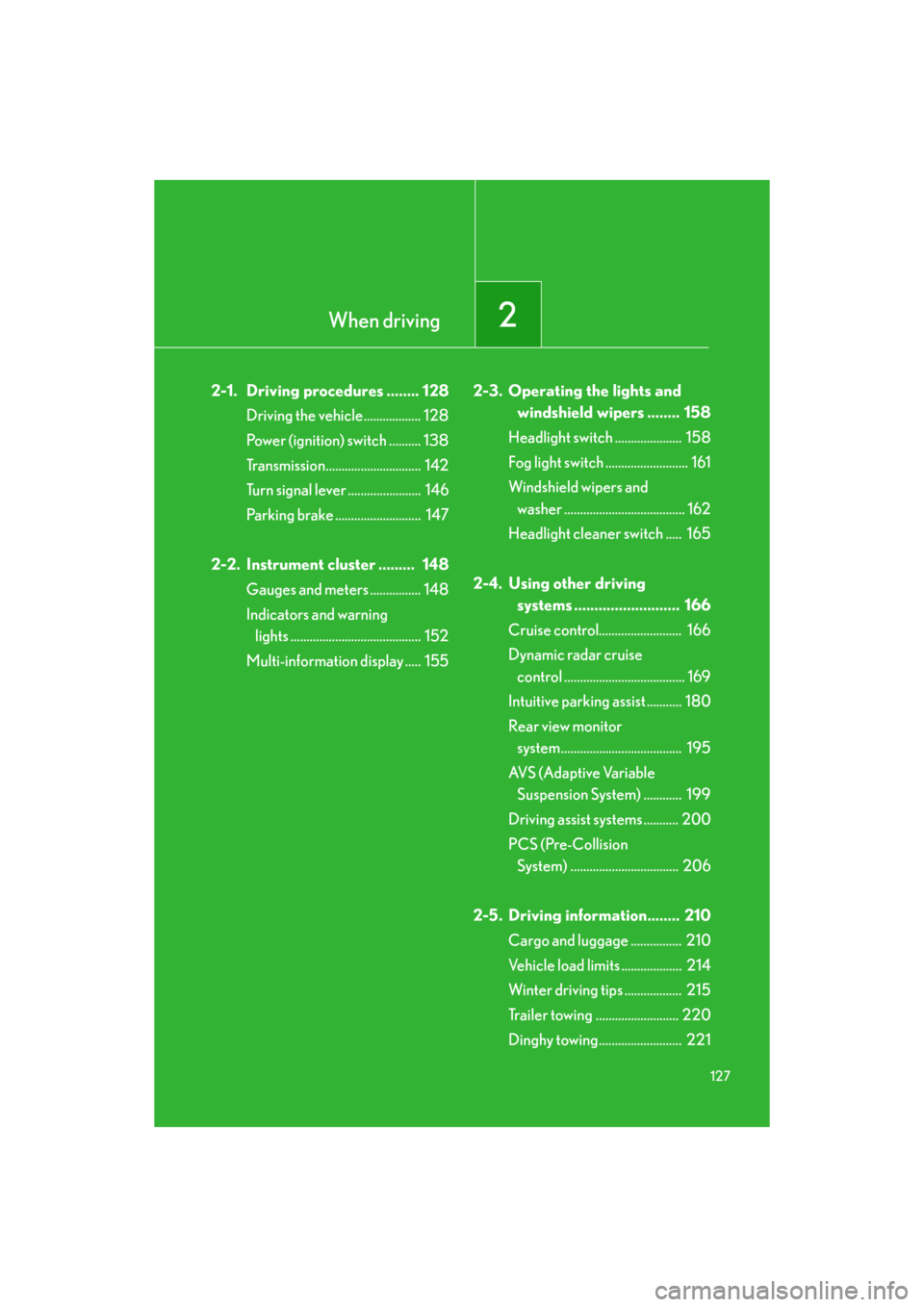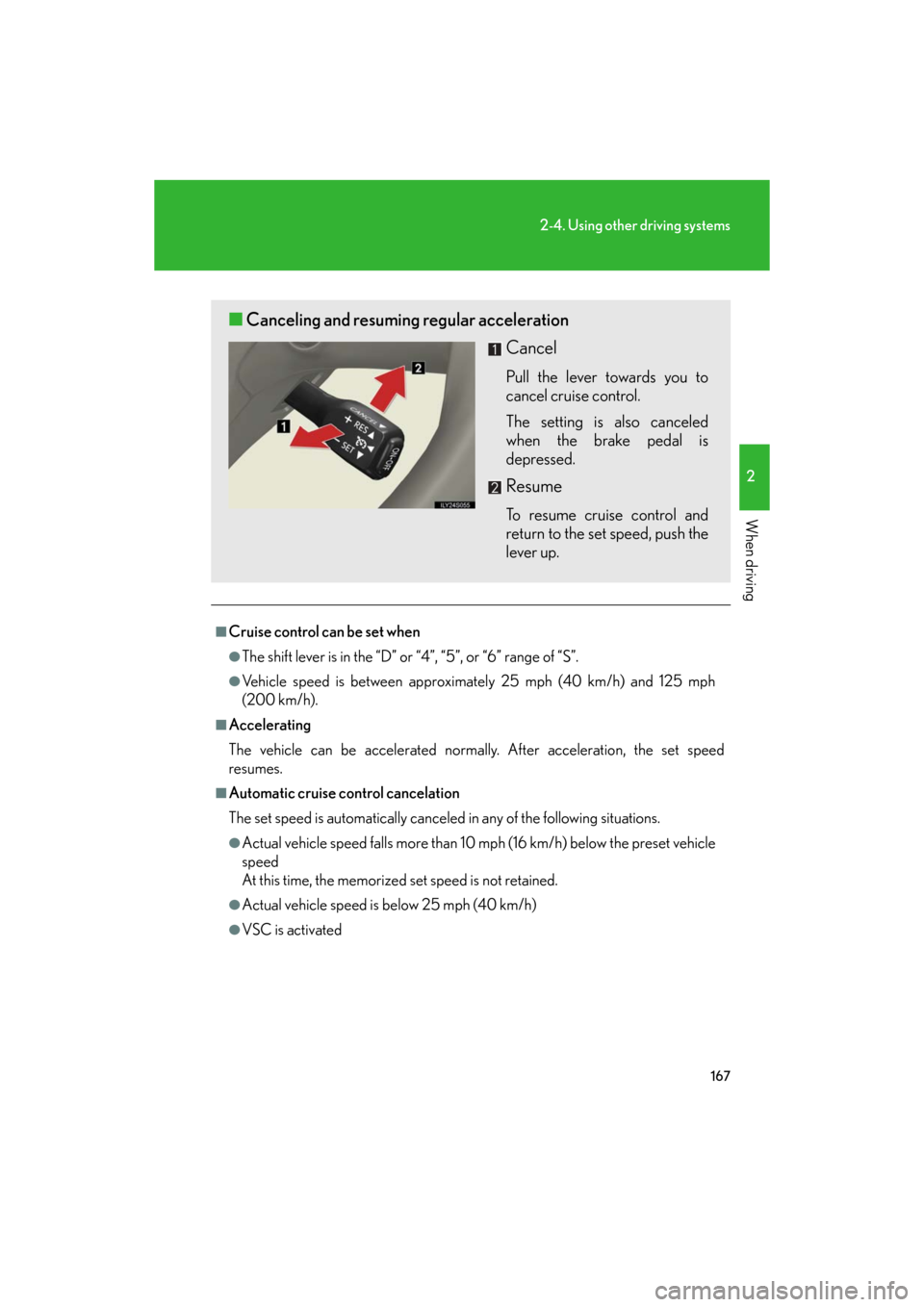tow Lexus GS450h 2008 Using the audio system / LEXUS 2008 GS450H (OM30A96U) User Guide
[x] Cancel search | Manufacturer: LEXUS, Model Year: 2008, Model line: GS450h, Model: Lexus GS450h 2008Pages: 596, PDF Size: 9.36 MB
Page 127 of 596

When driving2
127
GS_HV_U
December 12, 2007 3:33 pm
2-1. Driving procedures ........ 128Driving the vehicle.................. 128
Power (ignition) switch .......... 138
Transmission.............................. 142
Turn signal lever ....................... 146
Parking brake ........................... 147
2-2. Instrument cluster ......... 148 Gauges and meters ................ 148
Indicators and warning
lights ......................................... 152
Multi-information display ..... 155 2-3. Operating the lights and
windshield wipers ........ 158
Headlight switch ..................... 158
Fog light switch .......................... 161
Windshield wipers and
washer ...................................... 162
Headlight cleaner switch ..... 165
2-4. Using other driving
systems .......................... 166
Cruise control.......................... 166
Dynamic radar cruise
control ...................................... 169
Intuitive parking assist ........... 180
Rear view monitor
system...................................... 195
AVS (Adaptive Variable
Suspension System) ............ 199
Driving assist systems ........... 200
PCS (Pre-Collision
System) .................................. 206
2-5. Driving information........ 210 Cargo and luggage ................ 210
Vehicle load limits ................... 214
Winter driving tips .................. 215
Trailer towing .......................... 220
Dinghy towing.......................... 221
Page 158 of 596

158
GS_HV_U
May 19, 2008 9:00 pm
2-3. Operating the lights and windshield wipers
Headlight switch
Turning on the high beam headlightsWith the headlights on, push the
lever forward to turn on the high
beams.
Pull the lever back to the center
position to turn the high beams off.
Pull the lever toward you to turn
on the high beams.
Release to turn them off. You can
flash the high beams with the head-
lights on or off.
The headlights can be operated manually or automatically.
The side marker, parking,
tail, license plate and
instrument panel lights
turn on.
The headlights and all lights listed above turn
on.
The headlights and all the lights listed above turn
on and off automatically.
(When the “POWER”
switch is in ON mode.)
U.S.A.
Canada
Page 164 of 596

164
2-3. Operating the lights and windshield wipers
GS_HV_U
May 19, 2008 9:00 pm
CAUTION
■Caution regarding the use of windshield wipers in “AUTO” mode
The windshield wipers may operate unexpectedly if the sensor is touched or the
windshield is subject to vibration in “AUTO” mode. Take care that your fingers or
anything else do not become caught in the windshield wipers.
NOTICE
■When the windshield is dry
Do not use the wipers, as they may damage the windshield.
■When there is no washer fluid spray from the nozzle
Damage to the washer fluid pump may be caused if the lever is pulled toward you
and held continually.
Page 167 of 596

167
2-4. Using other driving systems
2
When driving
GS_HV_U
January 4, 2008 10:02 am
■Cruise control can be set when
●The shift lever is in the “D” or “4”, “5”, or “6” range of “S”.
●Vehicle speed is between approximately 25 mph (40 km/h) and 125 mph
(200 km/h).
■Accelerating
The vehicle can be accelerated normally. After acceleration, the set speed
resumes.
■Automatic cruise control cancelation
The set speed is automatically canceled in any of the following situations.
●Actual vehicle speed falls more than 10 mph (16 km/h) below the preset vehicle
speed
At this time, the memorized set speed is not retained.
●Actual vehicle speed is below 25 mph (40 km/h)
●VSC is activated
■ Canceling and resuming regular acceleration
Cancel
Pull the lever towards you to
cancel cruise control.
The setting is also canceled
when the brake pedal is
depressed.
Resume
To resume cruise control and
return to the set speed, push the
lever up.
Page 171 of 596

171
2-4. Using other driving systems
2
When driving
GS_HV_U
January 4, 2008 10:02 am
■Canceling and resuming the speed setting
Cancel
Pull the lever towards you to
cancel cruise control.
The setting is also canceled
when the brake pedal is
depressed.
Resume
To resume cruise control and
return to the set speed, push the
lever up.
■Changing the vehicle-to-vehicle distance
Each pull of the switch changes
the vehicle-to-vehicle distance
Long
Medium
Short
The vehicle-to-vehicle distance
is automatically set to the long
mode when the “POWER”
switch is set to the ON mode.
A mark will be displayed to indi-
cate the presence of the vehicle
if a vehicle is running ahead of
you.
Preceding
vehicle mark
Page 192 of 596

192
2-4. Using other driving systems
GS_HV_U
January 4, 2008 10:02 am
●In the following situations, the intuitive parking assist may not function correctly,
possibly leading to an accident.
• There is ice, snow or mud on the sensors. (Wiping the sensors will resolve this
problem.)
• The sensor area is frozen. (Thawing the area will resolve this problem.)
In especially cold weather, if a sensor is frozen the screen may show an abnor-
mal display, or obstacles may not be detected.
• The vehicle angle is especially wide.
• In harsh sunlight or intense cold weather.
• When driving on bumpy, sloped or gravel roads, or over grass.
• If there is something producing ultrasonic waves nearby, such as another vehicle’s horn, motorcycle engine nois e, air braking sound from heavy-duty
vehicles, or another vehicle using the intuitive parking assist.
• In heavy rain, or if water is splashed on the sensors.
• If a commercial fender pole or radio antenna is installed.
• If towing eyelet is installed on your vehicle.
• If moving towards a high curb or a curb corner.
• Objects such as signs may cause the detection distance to shorten.
• The area directly under the bumpers is not detected.
Objects lower than the sensor s or thin stakes etc. may be detected initially,
but as they draw closer, they may cease to be detected.
• If obstacles draw too close to the sensor.
■Obstacles that may not be detected correctly
The following obstacles may not be detected.
●Thin objects such as wire, fencing or rope.
●Objects that absorb sound wave s, such as cotton or snow.
●Objects with sharp corners.
●Objects where the upper section projects out over the lower section.
●Low objects.
■If the display flashes and a message is displayed
P. 5 1 2
Page 210 of 596

210
GS_HV_U
December 12, 2007 3:50 pm
2-5. Driving information
Cargo and luggage
Capacity and distributionCargo capacity depends on the to tal weight of the occupants.
(Cargo capacity) = (Total load capa city) — (Total weight of occupants)
Steps for Determining Correct Load Limit—
(1) Locate the statement “The combined weight of occupants and cargo should never exceed XXX kg or XXX lbs.” on your vehicle’s
placard.
(2) Determine the combined weight of the driver and passengers that
will be riding in your vehicle.
(3) Subtract the combined weight of the driver and passengers from
XXX kg or XXX lbs.
Take notice of the following informat ion about storage precautions, cargo
capacity and load.
● Stow cargo and luggage in the trunk whenever possible. Be sure all
items are secured in place.
● Be careful to keep the vehicle leve l. Placing the weight as far for-
ward as possible helps maintain vehicle balance.
● For better fuel economy, do not carry unnecessary weight.
Page 211 of 596

211
2-5. Driving information
2
When driving
GS_HV_U
December 12, 2007 3:50 pm
(4) The resulting figure equals the available amount of cargo and lug-
gage load capacity.
For example, if the “XXX” amount equals 1400 lbs. and there will be
five 150 lb passengers in your vehicl e, the amount of available cargo
and luggage load capacity is 650 lbs. (1400 - 750 (5 150) = 650
lbs.)
(5) Determine the combined weight of luggage and cargo being
loaded on the vehicle.
That weight may not safely exceed the available cargo and luggage
load capacity calculated in Step 4.
(6) If your vehicle will be towing a trailer, load from your trailer will be transferred to your vehicle. Co nsult this manual to determine how
this reduces the available cargo and luggage load capacity of your
vehicle. ( P. 214)
Lexus does not recommend towing a tra iler with your vehicle. Your vehicle
is not designed for trailer towing.
Page 214 of 596

214
2-5. Driving information
GS_HV_U
December 12, 2007 3:50 pm
Vehicle load limits
■Total load capacity and seating capacity
These details are also described on the tire and loading information label.
( P. 445)
CAUTION
■Overloading the vehicle
Do not overload the vehicle.
It may not only cause damage to the tire s, but also degrade steering and braking
ability, resulting in an accident.
Vehicle load limits include total load capacity, seating capacity, towing
capacity and cargo capacity.
■ Total load capacity: 815 lb. (370 kg)
Total load capacity means the comb ined weight of occupants, cargo
and luggage.
■ Seating capacity: 5 occupants (Front 2, Rear 3)
Seating capacity means the maximu m number of occupants whose
estimated average weight is 150 lb. (68 kg) per person.
Even if the number of occupants ar e within the seating capacity, do
not exceed the total load capacity.
■ Towing capacity
Lexus does not recommend towing a trailer with your vehicle.
■ Cargo capacity
Cargo capacity ma y increase or decrease depending on the weight
and the number of occupants.
Page 220 of 596

220
2-5. Driving information
GS_HV_U
December 12, 2007 3:50 pm
Trailer towing
Lexus does not recommend towing a trailer with your vehicle. Lexus also
does not recommend the installation of a tow hitch or the use of a tow hitch
carrier for a wheelchair, scooter, bicycle, etc. Your Lexus is not designed
for trailer towing or for the us e of tow hitch mounted carriers.